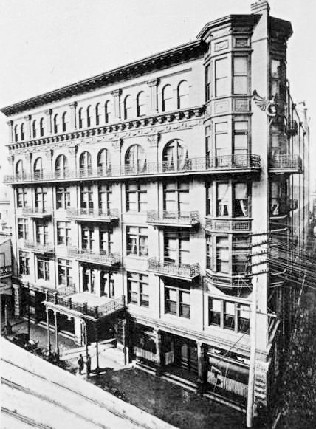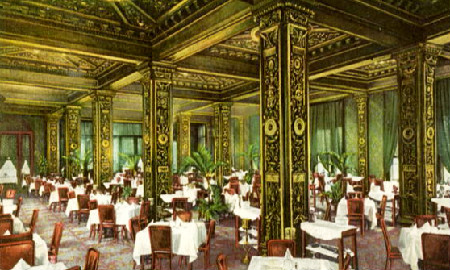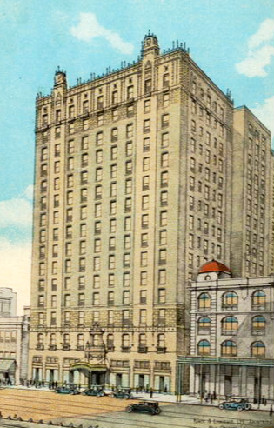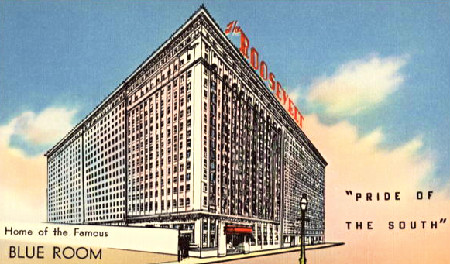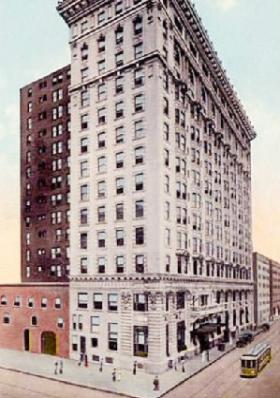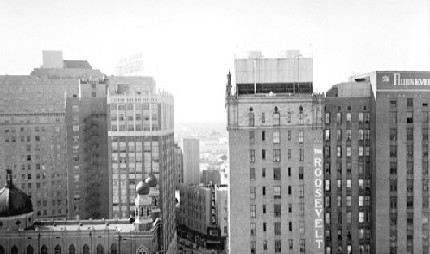
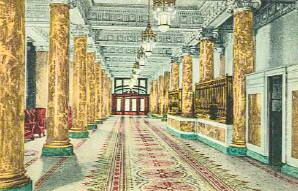
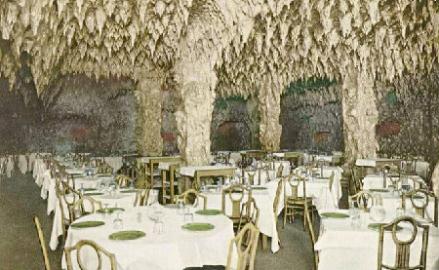
| The Historic Roosevelt Hotel |
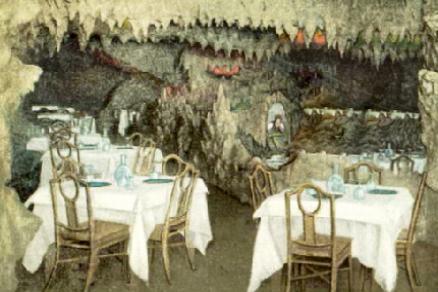
When The Grunewald was established in 1893, it was a six-story, 200-room hotel. In
1908, it was expanded with a fourteen-story, 400-room annex. It was, also, at this time
that what is believed to be America's first nightclub was opened. The subterranean
supper club called "The Cave" came complete with waterfalls, stalagmites, stalactites
and a line of chorus girls dancing to a Dixieland Jazz band. It's said that Louis
Grunewald was attempting to duplicate the environment of Kentucky's Mammoth Cave
- with the help of 700,000 pounds of plaster and cement. The Cave became a popular
place for New Orleanians and visitors alike and remained open until 1930. It was the
forerunner to the famed Blue Room which opened in 1935.
The Grunewald family ran the hotel until 1923, when it was sold and the name was
changed to honor former President Theodore Roosevelt. Eventually, it was purchased
by Seymour Weiss, who managed it for over thirty years. Weiss was a confidant of Gov.
Huey Long and the governor regularly used the hotel as a home-away-from-home.
The hotel was sold to the Fairmont group in 1965 and the name changed to The
Fairmont, though most locals continued to call it The Roosevelt.
The levee failures of 2005 caused extensive damage to the historic hotel and it
remained closed for 4 years. It was purchased in 2007 and has been restored - rather
than just renovated - to the grand hotel of its luxurious past. The restoration cost
over $170 million dollars and, in 2009, it re-opened under its historic Roosevelt name.
It is now a jewel in the crown of Hilton's prestigious Waldorf-Astoria line.
The city welcomed it back with the sort of celebration only New Orleans can muster.
Each place, each building, each beloved landmark that has been returned to the city
since the levee failures, is a joy and a balm for the heart of every New Orleanian. And
the re-opening of The Roosevelt was just such a joy.
1908, it was expanded with a fourteen-story, 400-room annex. It was, also, at this time
that what is believed to be America's first nightclub was opened. The subterranean
supper club called "The Cave" came complete with waterfalls, stalagmites, stalactites
and a line of chorus girls dancing to a Dixieland Jazz band. It's said that Louis
Grunewald was attempting to duplicate the environment of Kentucky's Mammoth Cave
- with the help of 700,000 pounds of plaster and cement. The Cave became a popular
place for New Orleanians and visitors alike and remained open until 1930. It was the
forerunner to the famed Blue Room which opened in 1935.
The Grunewald family ran the hotel until 1923, when it was sold and the name was
changed to honor former President Theodore Roosevelt. Eventually, it was purchased
by Seymour Weiss, who managed it for over thirty years. Weiss was a confidant of Gov.
Huey Long and the governor regularly used the hotel as a home-away-from-home.
The hotel was sold to the Fairmont group in 1965 and the name changed to The
Fairmont, though most locals continued to call it The Roosevelt.
The levee failures of 2005 caused extensive damage to the historic hotel and it
remained closed for 4 years. It was purchased in 2007 and has been restored - rather
than just renovated - to the grand hotel of its luxurious past. The restoration cost
over $170 million dollars and, in 2009, it re-opened under its historic Roosevelt name.
It is now a jewel in the crown of Hilton's prestigious Waldorf-Astoria line.
The city welcomed it back with the sort of celebration only New Orleans can muster.
Each place, each building, each beloved landmark that has been returned to the city
since the levee failures, is a joy and a balm for the heart of every New Orleanian. And
the re-opening of The Roosevelt was just such a joy.
| Above, The Grunewald, 1895; photo at top of page, Grunewald's main dining room, 1911. |
| 1920's card reads: "The new Roosevelt Hotel fronting Baronne Street near Canal and extending to University Place. In the heart of New Orleans. The largest and finest hotel in the South. It has been designed to meet the demand for the highest type of hotel service. Under the personal supervision of Author Benaglia, it provides more than 1,200 strictly first-class rooms, each with a bath." |
| Grunewald, 1911 |
| Above & below, Grunewald lobby, 1908 |
| The Cave |
| Card reads: "The Roosevelt Hotel, the Pride of the South. It is the home of the famous Blue Room, New Orleans' finest supper club. A 100% air-conditioned hotel." Date unknown. |
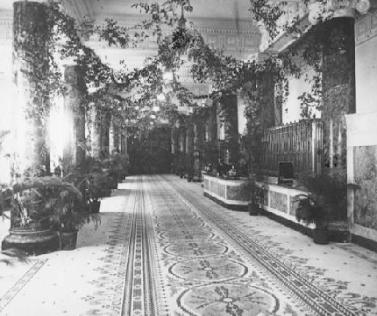
| The link to this page is: http://old-new-orleans.com/NO_Roosevelt.html The Roosevelt Hotel's Blue Room Back to Old New Orleans Whispers - Home |
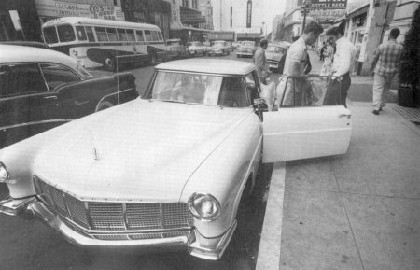
| A view down Baronne Street, ca. 1946: to the right, Roosevelt Hotel buildings; to the left, Jesuit Church; center, the old Sears store. |
The Roosevelt has not only had a long history, but a very colorful one, as well. If
you've ever read Arthur Hailey's novel, "Hotel," you may know more about The
Roosevelt than you suspected, it was supposedly the inspiration for the
best-selling novel. Employees watched as Hailey took copious notes throughout
the hotel and said they could easily identify many of the characters written about in
the book.
Scores of celebrities have stayed at the hotel, many while performing in the Blue
Room. My aunt worked for a time as a switchboard operator at the hotel years ago
and came away with lots of interesting celebrity stories.
Elvis Presley stayed at the hotel while making the movie "King Creole." Above, he
exits one of his trademark Cadillacs at The Roosevelt's entrance, 1958.
you've ever read Arthur Hailey's novel, "Hotel," you may know more about The
Roosevelt than you suspected, it was supposedly the inspiration for the
best-selling novel. Employees watched as Hailey took copious notes throughout
the hotel and said they could easily identify many of the characters written about in
the book.
Scores of celebrities have stayed at the hotel, many while performing in the Blue
Room. My aunt worked for a time as a switchboard operator at the hotel years ago
and came away with lots of interesting celebrity stories.
Elvis Presley stayed at the hotel while making the movie "King Creole." Above, he
exits one of his trademark Cadillacs at The Roosevelt's entrance, 1958.
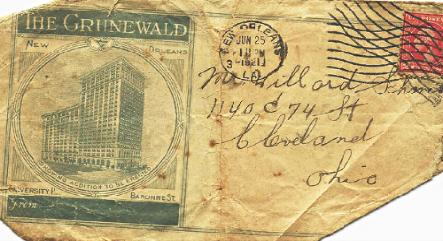
| Many thanks to Jon Petersen, who shared the image above -- a 1921 Hotel Grunewald envelope. Since the name was changed in 1923, I would doubt that many Grunewald envelopes survive today. |
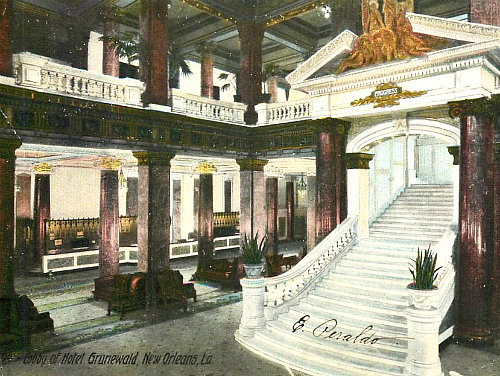
| Grunewald lobby, early 1900's |
